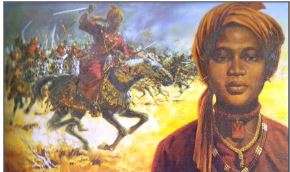Amina

Amina (also Aminatu; d. 1610) was a Hausa Muslim Warrior Queen of Zazzau (now Zaria), in what is now north west Nigeria.[1] She is the subject of many legends, but is believed by historians to have been a real ruler. There is controversy among scholars as to the date of her reign, one school placing her in the mid-15th century, and a second placing her reign in the mid to late 16th century.
The Arabic female name Amina means truthful, trustworthy and honest.
History and sources
The earliest source to mention Amina is Muhammed Bello's history Ifaq al-Maysur, composed around 1836. He claims that she was "the first to establish government among them," and she forced Katsina, Kano and other regions to pay tribute to her.[2] Bello, unfortunately provided no chronological details about her. She is also mentioned in the Kano Chronicle, a well-regarded and detailed history of the city of Kano, composed in the late 19th century, but incorporating earlier documentary material. According to this chronicle, she was a contemporary of Muhammad Dauda, who ruled from 1421–38, and Amina conquered as far as Nupe and Kwarafa, collected tribute from far and wide and ruled for 34 years.[3] A number of scholars accept this information and date her reign to the early to mid-15th century.[4][5]
There is also a local chronicle of Zaria itself, written in the 19th century (it goes up to 1902) and published in 1910 that gives a list of the rulers and the duration of their reigns.[6] Amina is not mentioned in this chronicle, but oral tradition in the early 20th century held her to be the daughter of Bakwa Turunku, whose reign is dated by the chronicle from 1492–1522, and on this basis some scholars date her reign to the early 16th century.[7] Abdullahi Smith, using similar discripancies places her reign after 1576.[8] [9]
Legendary exploits
More recent oral tradition has a series of lively stories about the queen, and these have found their way into popular culture. Among them were: Amina was a fierce warrior and loved fighting. As a child, her grandmother Marka, the favorite wife of her grandfather Sarkin Nohir, once caught her holding a dagger. Amina holding the dagger did not shock Marka, rather it was that Amina held it exactly as a warrior would. As an adult, she refused to marry for the fear of losing power. She helped Zazzau (Zaria) become the center of trade and to gain more land. Her mother, Bakwa, died when Amina was 36 years old, leaving her to rule over Zaria. She was also said to have taken a lover from among the conquered people after each battle, and to have killed or castrated him in the morning following their night together.[10]
Legacy
- The introduction of kola nuts into cultivation in the area is attributed to Amina. The Queen Amina Statue at the National Arts Theatre in Lagos State honors her, and multiple educational institutions bear her name.[11] She is widely credited with building the earthen walls that surround Hausa cities.
- The warrior princess Amina Zarinde character who appears in "Elf Saga: Doomsday" (2014) by Joseph Robert Lewis is partly inspired by the Hausa queen.
References
- ↑ PBS.org - Global Connections: Roles of Muslim Women
- ↑ Muhammad Bello, Infaq 'l-Maysuur, chapter 7, translated Muhammad Shareef, (Sennar, Sudan,2008) http://www.siiasi.org/Chapter%207%20_Infaaq_.pdf
- ↑ H. R. Palmer, ed. "The Kano Chronicle," Journal of the Anthropological Institute of Great Britain and Ireland 38 (1908), p. 75.
- ↑ R. A. Adeleye, "Hausaland and Bornu, 1600-1800," in J. F. Ajayi and Michael Crowder, eds. History of West Africa (2 vols., London, 1971) vol. 1
- ↑ Humphrey Fisher. "The Eastern Maghreb and the Central Sudan," Cambridge History of Africa (8 vols., Cambridge, 1977) 3: 232-330.
- ↑ E. J. Arnett, "A Hausa Chronicle" Journal of the Royal African Society 9 (1910), p. 161-62; 165.
- ↑ S. J. Hogben and A. H. Kirk-Greene, The Emirates of Northern Nigeria: A Preliminary Survey of their Historical Traditions (London, 1966), pp. 216-218.
- ↑ Abdullahi Smith,"Some Notes on the History of Zauzau under the Hausa Kings," in M. J. Mortimore, ed., Zaria and its Region: A Nigerian Savannah City and its Environs (Zaria, 1970).
- ↑ M Adamu, "The Hausa and their Neighbors in the Central Sudan," in D. T. Niane, ed., UNESCO General History of Africa (London and Los Angeles, 1984) 4: 275.
- ↑ "Amina of Zaria," in UXL Encyclopedia of World Biography (2003), http://findarticles.com/p/articles/mi_gx5229/is_2003/ai_n19152012/
- ↑ Jones, David E (2000). Women Warriors: A History. Brassey's. p. 84. ISBN 1-57488-206-6.